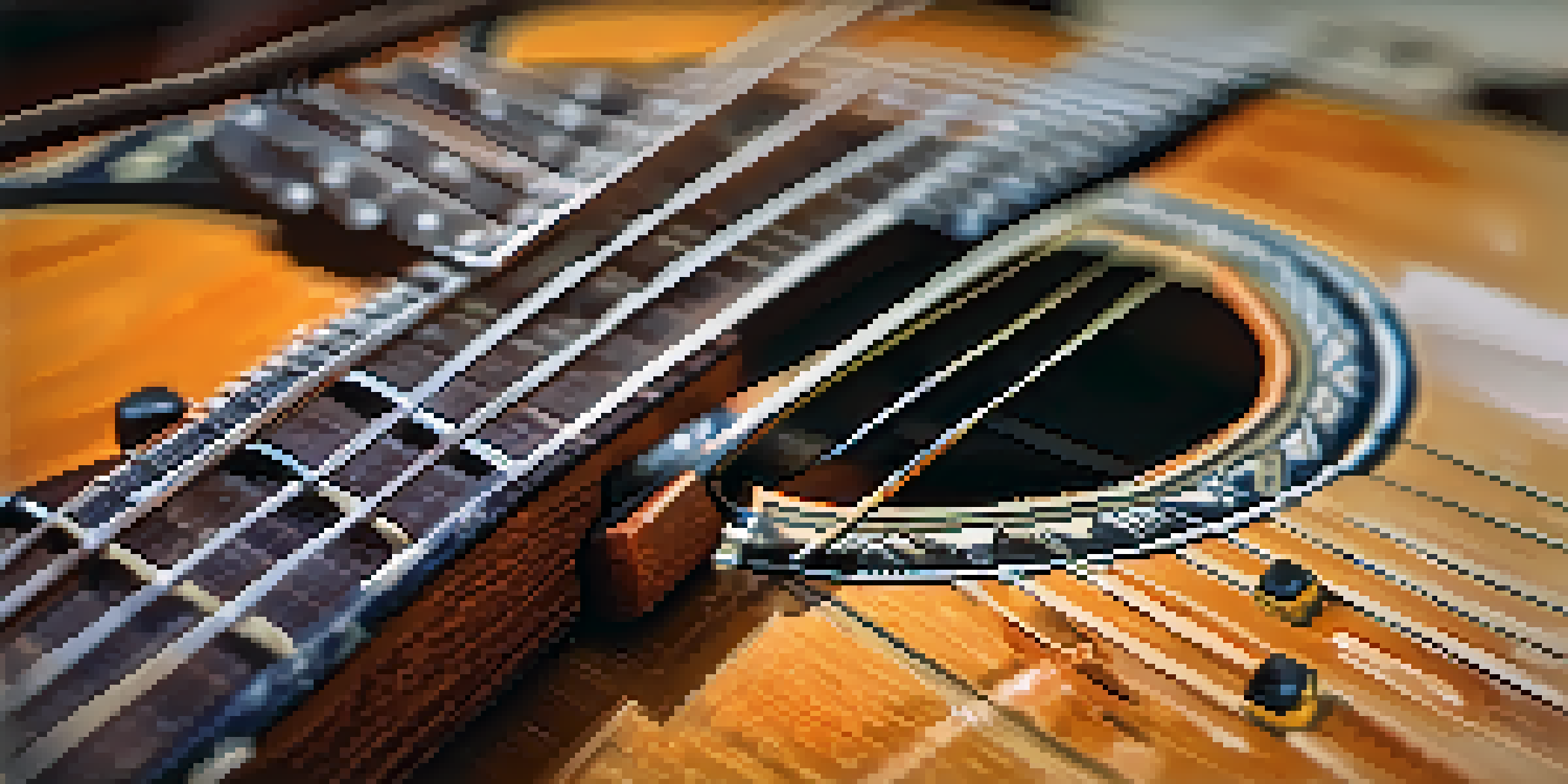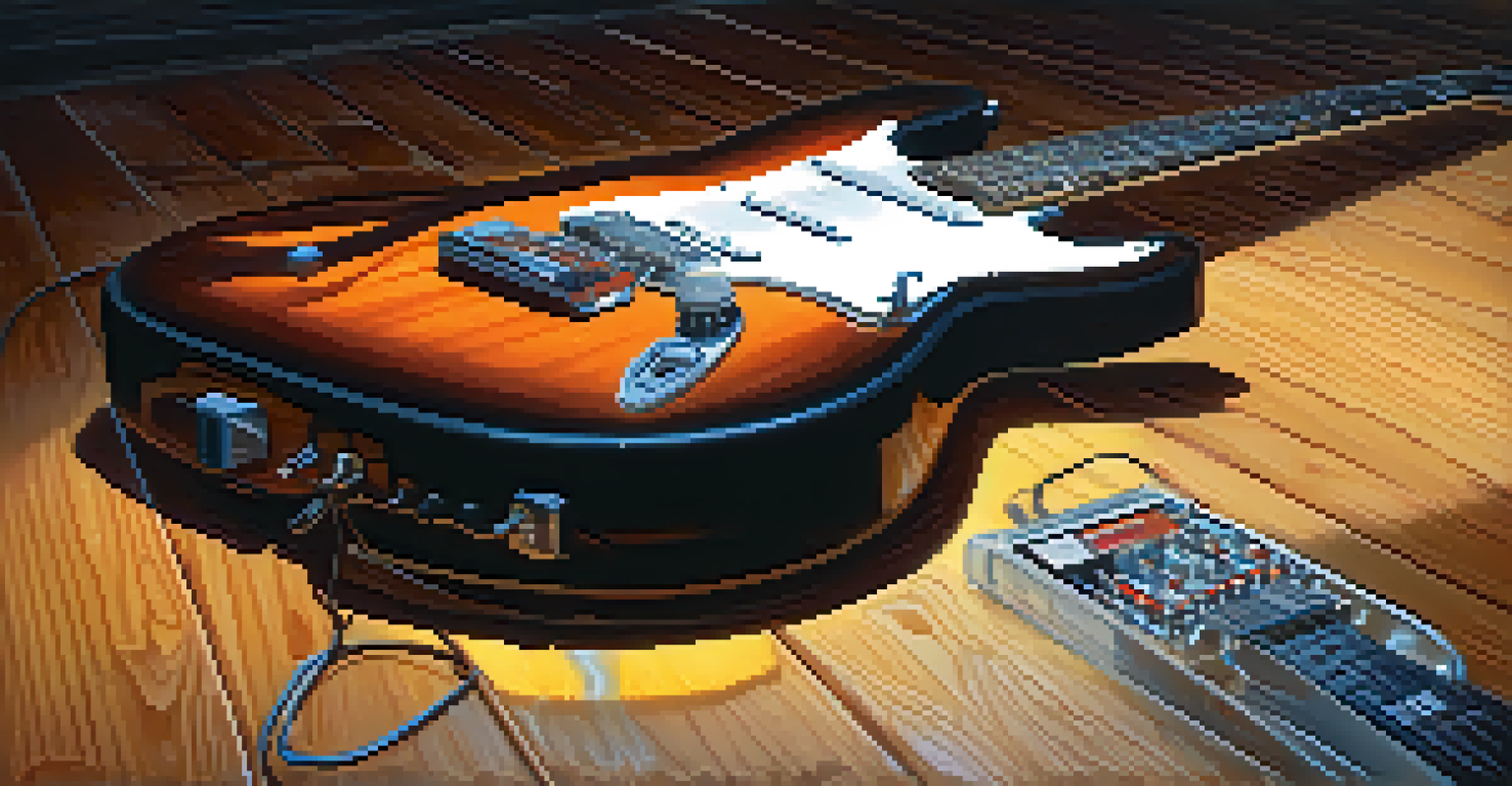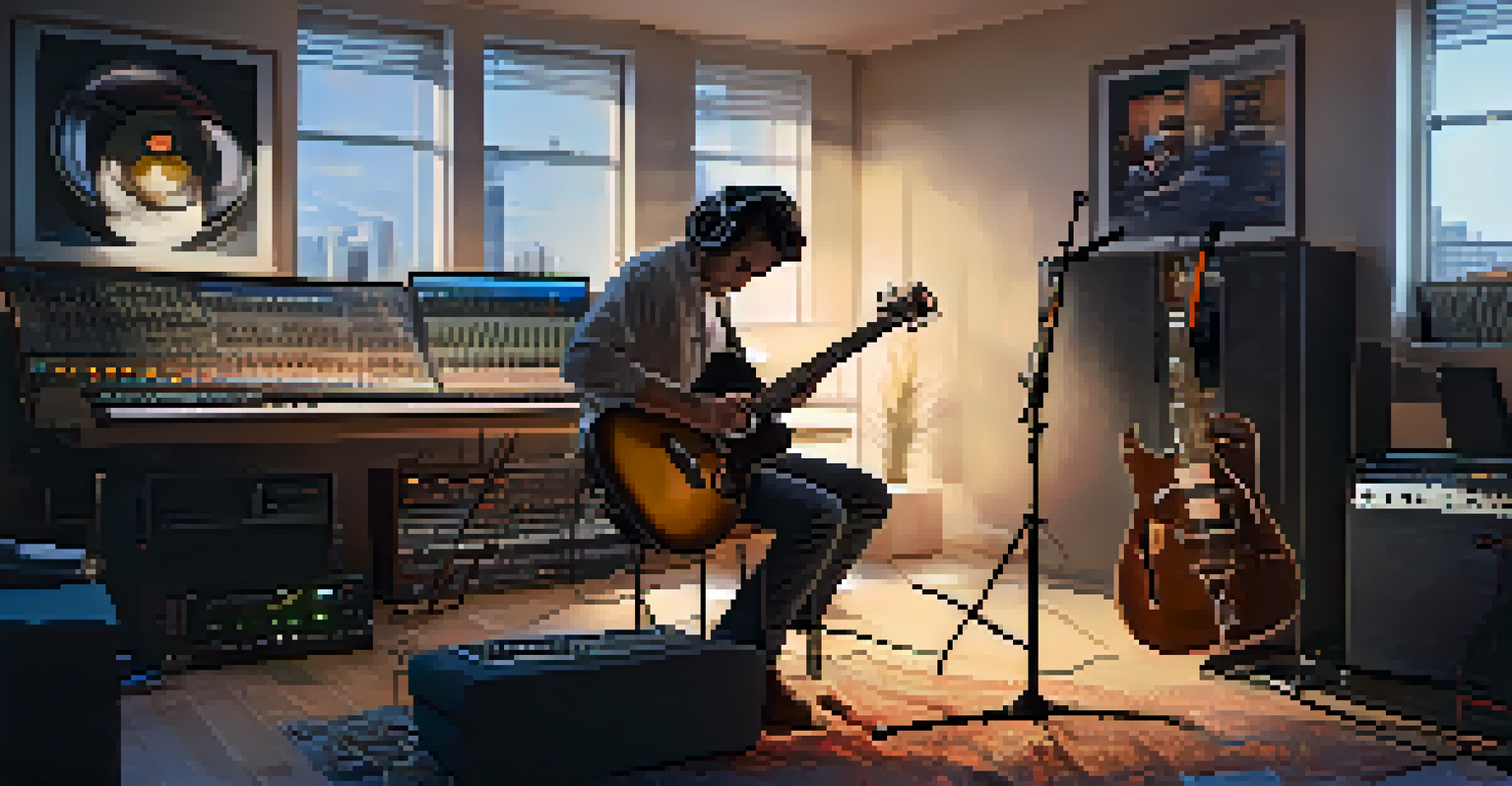The Impact of Technology on Guitar Sounds in Music

The Evolution of Guitar Technology and Sound
The guitar has seen a remarkable evolution in its design and technology over the decades. From the classic wooden acoustic guitars to the sleek electric models we know today, advancements have fundamentally changed how we experience sound. This transformation isn't just cosmetic; it involves intricate engineering that enhances tonal quality, resonance, and playability.
Music is the shorthand of emotion.
For example, the introduction of solid-body electric guitars revolutionized rock music, allowing musicians to achieve higher volumes without feedback issues. Additionally, the use of materials like carbon fiber and various woods has enabled luthiers to experiment with sound in innovative ways. This ongoing evolution showcases how technology and creativity intertwine to shape musical expression.
Moreover, the rise of digital tools has expanded possibilities even further, giving guitarists access to a wide range of tones and effects that were previously unimaginable. As we dive deeper into the impact of technology on guitar sounds, we’ll explore how these innovations continue to influence the music we love.
Effects Pedals: Transforming Guitar Sounds
Effects pedals have become essential tools for guitarists, enabling them to manipulate their sound in real-time. These small devices can create a vast array of effects, from distortion to reverb, providing musicians with the ability to craft their unique soundscapes. By simply stepping on a pedal, guitarists can instantly change the mood of their performance, making effects pedals a game-changer in the world of music.

For instance, iconic sounds like the fuzz of a classic rock anthem or the ethereal tone of a shoegaze track often originate from a combination of effects pedals. The flexibility that these devices offer allows musicians to blend genres and experiment with their sound, pushing creative boundaries. It's fascinating how a simple stomp can lead to a world of sonic exploration.
Guitar Tech Revolutionizes Sound
Advancements in guitar technology, from solid-body electric guitars to digital tools, have fundamentally transformed musical expression and sound quality.
Additionally, the growing trend of analog vs. digital pedals has sparked debates within the guitar community. While analog pedals are cherished for their warmth and character, digital options provide versatility and convenience. This ongoing discussion highlights how technology continues to shape not just the sounds produced but the very culture surrounding guitar music.
Digital Audio Workstations (DAWs) and Guitar Production
Digital Audio Workstations (DAWs) have revolutionized how music is produced, making it more accessible than ever. These software platforms allow musicians to record, edit, and mix their guitar sounds from the comfort of their homes. With powerful tools at their fingertips, artists can experiment with layering tracks and applying effects, streamlining the creative process.
Technology is best when it brings people together.
Many guitarists now find themselves producing high-quality music without the need for expensive studio time. This democratization of music production means that budding musicians can explore their craft without significant financial barriers. As a result, we’ve seen a surge in diverse voices and styles emerging in the music scene.
Moreover, DAWs often come equipped with virtual instruments and plugins that replicate the sounds of traditional gear, giving guitarists endless possibilities. By merging technology with creativity, musicians can push boundaries and redefine what’s possible in their compositions, allowing for richer and more complex guitar arrangements.
The Role of MIDI in Guitar Music Creation
MIDI, or Musical Instrument Digital Interface, has opened up new avenues for guitarists to create and manipulate music. This technology allows instruments and computers to communicate, enabling musicians to compose and control sounds in innovative ways. For guitarists, MIDI can be used to trigger virtual instruments or control effects, enhancing their performances and compositions.
For example, a guitarist can record a riff and use MIDI to layer it with synthesized sounds, creating a fuller, more dynamic track. This capability allows for a unique blend of traditional guitar playing with electronic music elements, broadening the scope of what can be achieved in a song. It’s like having an entire orchestra at your fingertips, ready to complement your guitar work.
Effects Pedals Enhance Creativity
Effects pedals allow guitarists to manipulate their sound in real-time, facilitating a unique blend of genres and expanding creative possibilities.
As technology continues to evolve, the integration of MIDI in guitar music will likely become even more prevalent. This synergy not only fosters creativity but also encourages collaboration across genres, making it an exciting time for guitarists looking to explore new musical landscapes.
The Impact of Online Streaming on Guitar Music
The rise of online streaming platforms has transformed how music is consumed and shared, significantly impacting guitar music. With services like Spotify and Apple Music, guitarists can reach a global audience without the need for a record label. This accessibility allows emerging artists to showcase their talent and connect with fans in ways that were previously unimaginable.
Moreover, streaming platforms often feature curated playlists that highlight guitar-driven genres, giving artists more exposure. This shift has led to a resurgence of guitar-centric music, as listeners increasingly seek out new sounds and styles. Guitarists can now gain recognition and build a following without relying solely on traditional media outlets.
However, this change also brings challenges, such as the need for artists to market themselves effectively in a crowded landscape. As guitarists adapt to this new environment, they must leverage technology and social media to promote their work. The impact of streaming on guitar music is undeniable, shaping not just how music is heard but how artists navigate their careers.
The Future of Guitar Sounds in a Technological World
As technology continues to advance, the future of guitar sounds looks incredibly promising. Innovations such as artificial intelligence and machine learning are being integrated into music production, offering guitarists new tools to experiment with sound. Imagine software that can analyze your playing style and suggest complementary chords or effects—this is no longer just a dream; it’s on the horizon.
Additionally, as virtual reality (VR) and augmented reality (AR) technologies develop, they may provide immersive ways for guitarists to practice and perform. Picture a virtual stage where you can play alongside your favorite musicians or receive real-time feedback on your technique. These advancements could redefine how we engage with music and the guitar itself.
Streaming Shapes Guitar Music's Future
The rise of online streaming platforms has democratized music distribution, enabling emerging guitarists to reach global audiences and cultivate their unique styles.
Ultimately, the fusion of technology and guitar sounds will continue to inspire creativity and innovation. As musicians embrace these tools, we can expect an exciting evolution in guitar music, leading to new genres and styles that reflect the ever-changing landscape of the musical world.
Conclusion: Embracing Technology for Musical Growth
In conclusion, the impact of technology on guitar sounds in music is profound and multifaceted. From the tools we use to create music to the platforms we share it on, technology has transformed every aspect of the guitar-playing experience. As we’ve explored, advancements like effects pedals, DAWs, and MIDI open up a world of possibilities for musicians.
Moreover, the accessibility of online streaming has leveled the playing field, allowing diverse voices to be heard. As guitarists embrace these technologies, they not only enhance their sound but also foster a sense of community and collaboration within the music world. This synergy between technology and creativity is essential for pushing the boundaries of what’s possible.

As we move forward, it’s vital for musicians to remain curious and open to new technologies. By doing so, they can continue to evolve their craft and contribute to the rich tapestry of guitar music, ensuring that it remains vibrant and relevant in an ever-changing landscape.